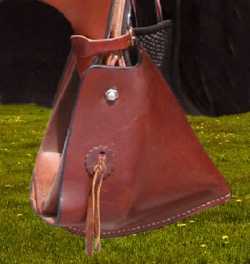|
By Jerry Tardif
 Fully Hooded Tapaderos
Fully Hooded Tapaderos
|
For some reason, tapaderos is a polarizing topic for many horse people.
People seem to either love tapaderos or hate them, and it's not clear why.
And more paradoxical, many people who hate them have never owned or even tried them.
Perhaps they just hate the way they look.
But, tapaderos can be a great accessory for those of us that enjoy riding outside, especially if that includes being in brush and wooded areas.
They incorporate safety and protection features for the rider that go beyond just wearing a good boot.
|
Here's what tapaderos are designed to do:
- Keep the foot from sliding too far into the stirrup and therefore reduce the risk of getting caught and dragged if you fall off your horse;
- Protect your feet from the cold;
- Protect your feet from rain, snow and splashed mud and slush while riding;
- Protect your feet from getting caught by brush while riding;
- Protect your feet from thorns, briars, cacti, cattle bites, and more.
Form the foregoing, you can see that tapaderos are best appreciated by trail riders, cowboys, endurance riders, and the like, for the additional protection and comfort they afford the feet.
Some come with straps in front so as to be cooler in warm weather while others are "fully hooded".
Obviously, the fully hooded versions provide the greatest foot protection and offer the least opportunity for something to "catch" the foot or stirrup.
Tapaderos are available in a large range of prices.
You can find them as inexpensively as $40.00 for a basic design to over $400 a pair for top quality leather handmade with sterling silver conchos.
Unless you're sure you'll like them, you may want to buy one of the inexpensive varieties first, to try them out.
In fact, they may be all you'll need and you may never buy a more expensive pair.
Besides being an avid trail rider, Jerry Tardif is a technology consultant and a horse and nature photographer in SE Connecticut — see his work at: www.jerrytardif.com.
He is also co-founder and President of QueryHorse.
Back to Article Index
|